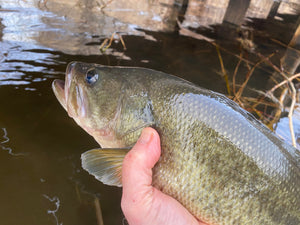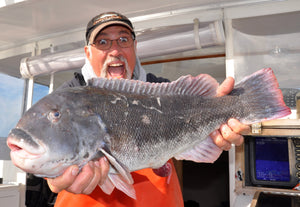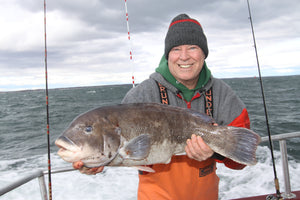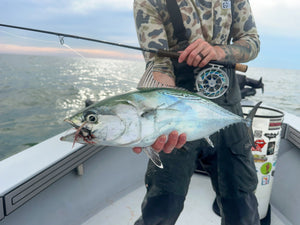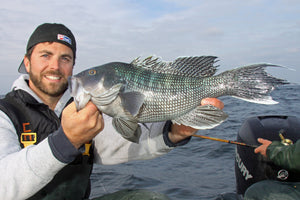Change Things Up For September Sweetness

By the time September rolls around, you can bet Long Island’s freshwater bass, pickerel, trout and panfish have pretty much seen it all in terms of lure presentations. Often sluggish and slow to respond to standard offerings having been pushed hard since early spring, it may take more than your usual assault at this point to trigger the bite.
Rather than work the same lures and techniques you generally favor, this is a great time to experiment. When conditions are right and fish are feeding heavily, any lure has a good chance of being productive. However, during September when bass and pickerel tend to be more neutral than aggressive, forcing yourself to learn a new technique or try a radically different lure can pay big dividends.

September change of pace, try tossing a small, Rapala floating minnow. It will often raise fresh fish right out in open water. OutdoorTom.com photo.
Instead of jigging, for example, you might switch to working poppers and twitch baits, as counter-intuitive as that may seem with the water so warm. A pop-and-stop retrieve with an Arbogast Hula Popper, or steady retrieve with a 2-inch Arbogast Jitterbug, can work wonders in pockets where the weeds don’t break the surface. Even better can casting twitch baits even though that seems counter-intuitive with the water so warm early in the month. Slowly twitching old school 3-1/2- to 4-3/8-inch Silver or Gold Rapala Original Floating Minnows across the surface with 6-pound test spinning outfits is a great way to go this month. Cast out, wait for the ripples to clear, and gently twitch the lure once or twice. Repeat this process several times and then reel it back at a slow to medium pace. Interestingly, this method often works late in the morning.
Often, the smack with twitch baits comes right at the surface following a twitch – but the biggest fish generally nail these offerings on the first few cranks of the reel after the lure pushes under the surface. To increase the number of big fish opportunities, stop reeling after about 15 feet, allow the lure to float back to the surface, and repeat the sequence throughout your retrieve. This is also a great trick for tempting big bluegill, pumpkinseed and crappie if you drop down to a 4-pound-test spinning outfit and 1.5- or 2-inch Rapala.

Open water September perch can be quite feisty and will quickly inhale flies, twitch baits or Trout Magnets. OutdoorTom.com photo.
The beauty of using twitch baits at this time of year, aside from the fact that they are really productive, is it forces you to move out of the weeds and slop to work more open waters that other anglers pass up. While there may actually be fewer fish on patrol once you move away from the shore and out of the shallows and smaller coves, they can be more inquisitive and easier to trigger when compared to bucketmouths caught along traditional slop fishing routes. Try this method adjacent to well-defined channel edges, at the mouth of a large cove, or right out in the middle of a mill pond if that’s the only spot with a weed-free surface.

A frog pattern did in this chunky largemouth. OutdoorTom.com photo.
Breaking out the long wand is another way to revive your fishing soul during the transition from summer to fall. Try leaving your usual gear home to ensure you’ll stay the course should you decide to give this approach a try. Start by tossing a large frog, mouse or other popper pattern around the deeper side of lilies and weed lines positioned well off the bank. Since few Long Island bass fans seriously pursue their quarry with fly gear, you just might tempt a lunker into striking at something she doesn’t recognize as having hooks. Any green hair frog or frog pattern popper should work well in the morning, but for afternoon sessions you might be surprised at the productivity of larger minnow patterns like an Enrico Puglisi A2Z in Dead Meat or Purple Magic.
Once the sun gets up in the sky you can also turn your attention to bluegills and pumpkinseed. For this, you might offer bright yellow, blue, red or white spider leg poppers over shallow flats on a 4- or 5-weight outfit with floating line. If the shore action fails to materialize, back out to deeper water and try your luck with crappie, yellow perch or white perch and fewer but bigger bluegill and pumpkinseed using an Enrico Puglisi Pumpkinseed Fly or Yellow Perch pattern. A plus for both of these patterns is that they sport weed guards. If the weeds aren’t too thick, you might also try tossing a 1/64-ounce Trout Magnet in White or Gold Glitter as it catches just about anything that swims. You’ll find this kind of fishing refreshingly restful and the perfect way to introduce novice anglers to fly-fishing as panfish are so much more agreeable than hot weather trout.

Big late-summer bluegills are suckers for bead-head nymphs and Trout Magnets, especially once you move out from shoreline structure. OutdoorTom.com photo.
Yet another option to change things up is to try a lake or pond you’ve never visited before. No doubt there’s several you’ve always wanted to try - or a couple to which you’ve never made time to return. There’s no time better than now to make that effort.
So, if you’ve spent the entire summer working a jig & pig, Senko worm or weedless frog repeatedly through the same waters, trying a different approach or visiting new or even forgotten waters might just breathe a little extra excitement and contentment into your sweetwater routine. It should also help the bass you seek make it to the cooling waters of October - when the biggest ones will freshen-up and begin searching for more filling meals.
- Bryce Poyer


